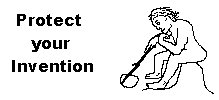
You will need to organize details about your invention in a disclosure to your patent representative. Basically, you should explain all of the important points of your invention in a written document, making reference to any figures required for a complete understanding of your invention. Left click here for a printable form to guide in organizing your thoughts. (The form will open in a new browser window). Quick-jump site map...
 e-mail us... e-mail us...
Inventor Services, LLC |
Overview of your Invention DisclosureAn invention disclosure should include a brief written description of your invention. The description should be complete enough to teach someone how to make and use your invention. However, choose a starting place that is appropriate for your invention. For instance, if you have invented an improvement to a prior art device, a prudent starting place might be to include a photograph of the old, or unimproved, prior art device. Perhaps the prior art may be described using one or more illustrations or pictures from a catalog. Then the improvement could be described, making reference to any relevant attachment structure of the old device. As an example, suppose you have invented a new shape for a metal spinner blade used in a fishing lure. Please don't explain how metal is made; that would be starting too far back. A few pages from a fishing supply catalog will illustrate the background art (currently available shapes for spinner blades). A hand drawn sketch of your new blade, with notes explaining how it attaches to certain spinners, and details about how the blade is made and used would probably suffice as a disclosure. The details about blade construction should include what materials would work as blades, any key design parameters: such as ratio of length-to-width-to-weight, and how you prefer to manufacture them. Any unexpected result of your new blade shape should be noted; such as if the blade reverses direction of rotation upon an increase in retrieve speed. It might be advantageous to include a prototype of your invention with your disclosure. Arrangements for return of prototypes, if desired, should be made in advance of sending any prototypes to your patent counsel. The description of your invention should particularly point out what you believe are the improvements over any existing similar prior art devices or methods for doing something. The length of the description depends only upon the complexity of your invention. Some inventions can be described on the back of an envelope, while others may require a significant manuscript and several drawing sheets. One or mores sketches or drawings, showing the device and indicating all of the important features, should generally be included. Hand drawn sketches are an excellent way to describe your invention to your patent counsel. Formal drawings may be prepared by a professional draftsman after your application is indicated to contain allowable subject matter. It may be helpful to use leader lines and arrows to indicate important features. Make legible notes describing key features and how they interact, if not apparent from the sketch. Alternative forms of your invention should also be illustrated and/or described, even if they are not currently the most preferred form of your invention. The disclosure is used as a tool to teach your patent practitioner all about your invention so that the patent application will be complete. A complete disclosure is also required by Inventor Services before a firm estimate of your costs to prepare a patent application can be provided. Please let us know if you have any specific questions. Inventor Services' Home | Patents | Invention Disclosure | Non-Disclosure Agreements | Fees | FAQ | Privacy Policy | SITE MAP | Feedback for Webmaster |